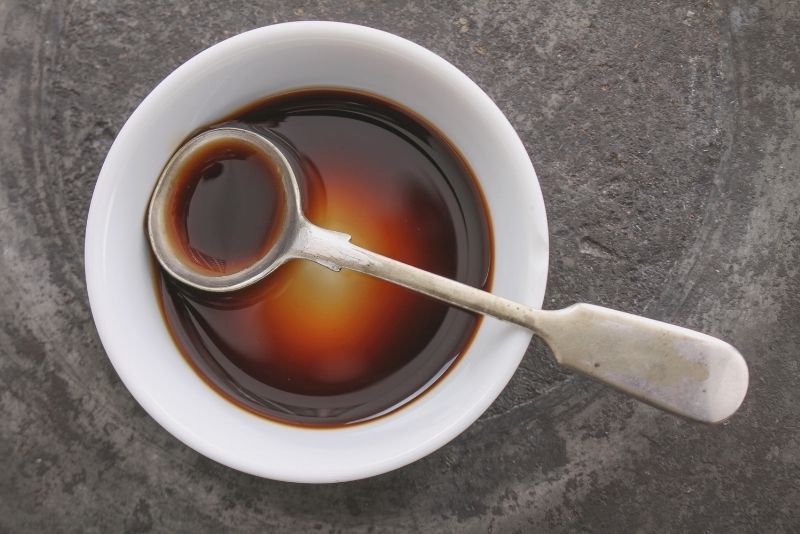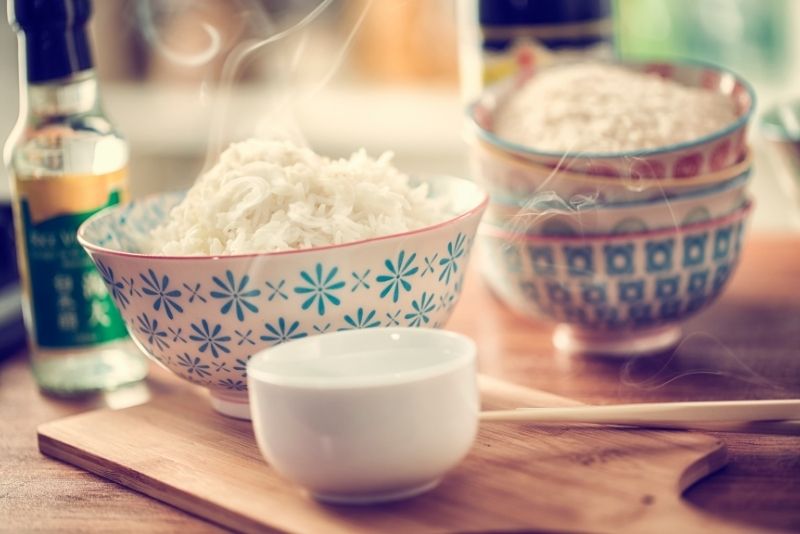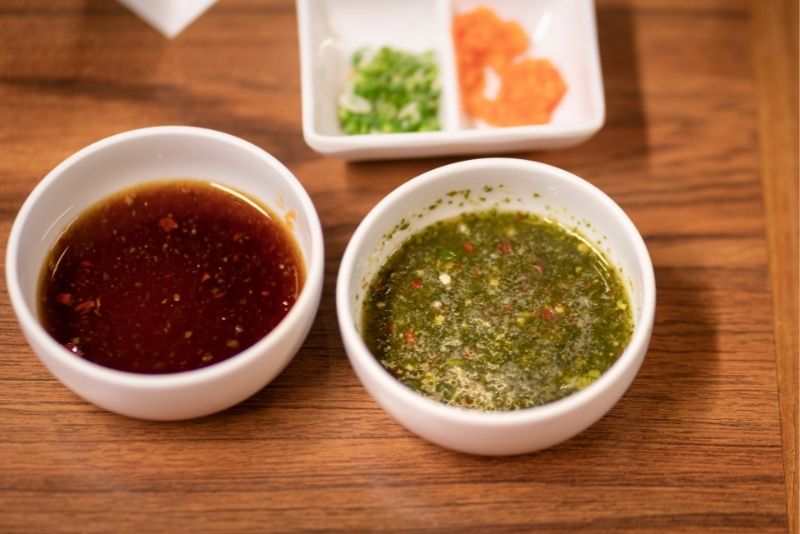Ponzu sauce is a Japanese condiment with a sweet and sour flavor. It is a delicious and versatile sauce that can be used in many recipes.
However, it’s hard to find good Ponzu sauce in the US, even at Japanese grocery stores. Most of the time you have to buy it online or make it yourself.
This makes cooking with Ponzu sauce difficult because ordering online takes too long and making your own requires ingredients that are hard to find outside of Japan.
I’ve compiled a list of the 9 best ponzu sauce substitutes and how you can use them so you’ll never have an excuse for running out again.
Keep reading as we discuss how you can use these alternatives in place of Ponzu sauce in your recipes, different types of Ponzu sauce, and more helpful information.
Table of Contents
9 Best Ponzu Sauce Substitutes
The best substitute for ponzu sauce are soy sauce and worcestershire sauce. You can also use rice vinegar, Nam Prik Pla, and lemon juice as ponzu sauce substitutes in most recipes.
So, if you’re in a pinch and need a ponzu sauce substitute, reach for one of the following:
1. Worcestershire Sauce

Worcestershire sauce is a fermented condiment with a vinegar base and seasonings like anchovies, molasses, tamarind, onion, garlic, and other spices.
This sauce has a tangy flavor profile that is complex and umami-rich.
Worcestershire sauce is a great ponzu sauce substitute because it has the same ingredients and flavor profile. The only difference is that its taste is deeper and richer, which makes it perfect to use in marinades.
Worcestershire sauce can be found in most grocery stores. There are many brands available but I recommend using Lea & Perrins Worcestershire Sauce because it doesn’t contain any artificial ingredients and its flavor is closest to ponzu.
2. Soy Sauce
Soy sauce is probably the best substitute for ponzu sauce, considering that soy sauce is the basis of Japanese cuisine.
Many types of ponzu are made by adding dashi, mirin, and other flavors to soy sauce. Soy sauce has a salty and umami flavor profile with a dark brown color.
Soy sauce is great for marinades, dressings, and dipping sauces. It is also easier to find than ponzu because it’s available in most grocery stores.
3. Rice Vinegar

Rice vinegar is a mild, sweet, and sour fermented condiment. It is one of the main ingredients in ponzu sauce and it’s also the most popular type of vinegar used in Japanese cooking.
You can easily find rice vinegar in any grocery store and it has a clear appearance with little flavor aside from its tartness.
Rice vinegar is great for dressing salads, sushi rice, noodles, and various other dishes.
It is a lot milder than other vinegar so it’s best to add it to recipes that have bold flavors or if you plan on using the sauce for dipping purposes.
4. Lemon Juice
Lemon juice has a tart and sour flavor profile that’s similar to ponzu sauce. The only difference is that it’s not as dark in color and doesn’t have the same umami flavors.
Lemon juice is great for making dressings, marinades, and dipping sauces. It pairs well with seafood dishes like sashimi, sushi rolls, fried calamari or fish, and various other recipes.
You can also use it to make takoyaki sauce by mixing it with takoyaki powder.
5. Nam Prik Pla
Nam Prik Pla is a Thai chili sauce that has an acidic flavor profile with fish paste, sugar, salt, and various spices.
It’s basically fish sauce diluted with water, lime juice, and chopped chilies or bird’s eye peppers.
Nam Prik Pla is a great substitute for ponzu sauce because it has the same ingredients, just with different proportions.
It is sweeter than ponzu but sour, salty, and umami at the same time.
You can use it in many recipes that call for ponzu sauce like sashimi, sushi rolls, fried calamari or fish, spring rolls, and various other recipes.
6. Orange Juice

Orange juice is very acidic and has a sweet and sour flavor that’s similar to ponzu sauce.
It doesn’t have the same flavor profile, but it does contain many of the same ingredients such as oranges, lemons, sugar, and salt.
The best thing about using orange juice as ponzu sauce substitute is that it’s readily available in most grocery stores.
It’s also perfect for making dressings, marinades, and dipping sauces.
You can use it to make the orange chicken sauce by mixing it with sweet chili sauce. It’s also a great substitute for apple cider vinegar in salad dressing recipes.
7. Yuzu Kosho
Yuzu Kosho is a Japanese condiment made from green yuzu fruit, salt, and chilies or red chili peppers.
The taste is salty, tangy, and spicy with a unique citrus flavor. It also contains the umami flavors of yuzu and red chili peppers.
You can make your own Yuzu Kosho by combining yuzu zest from green fruit with salt and chili pepper flakes.
Or you can purchase a jar of ready-made Yuzu Koshofrom from a Japanese or Asian grocery store.
Yuzu Kosho is great for marinating meats and seafood, dipping sauces, dressings, and various other recipes.
There are many different types of Yuzu Kosho so experiment with them until you find one that suits your taste preferences.
8. Mentsuyu
Mentsuyu is another popular Japanese sauce that’s made by boiling mirin, sake, sugar, and kombu in water.
It takes the flavors of the ingredients in different proportions to create a broth with similar flavors as ponzu sauce.
Mentsuyu can be consumed on its own because it has a light flavor or it can be used as an ingredient in various recipes.
You can use it as a soup base for ramen and udon noodles, dipping sauce for tempura and sashimi, dressing for salads and cold soba, and many other Japanese dishes.
9. Homemade Ponzu Sauce
Homemade ponzu sauce is the best substitute for all of you who want to make amazing sashimi, sushi rolls, or any other recipe that requires ponzu.
It’s incredibly easy to make and only takes 5 minutes. All you need are soy sauce, rice vinegar (or lemon juice), dashi stock (optional), mirin or sugar, and sesame oil.
You can make different variations of homemade ponzu sauce by adding other ingredients like grated ginger, scallions, chopped cilantro, wasabi paste, garlic chili sauce, or any other condiment that you enjoy.
Just experiment until you find a recipe that suits your taste preferences.
If you’re a vegetarian, you can make a vegetarian ponzu with kombu dashi instead of fish dashi.
You can also use homemade ponzu as a dipping sauce for sashimi and sushi rolls.
It’s delicious and you’ll never want to buy pre-made ponzu again once you taste the difference.
What is Ponzu Sauce?
Ponzu Sauce is a Japanese condiment that has a unique flavor. It consists of citrus juice, rice vinegar, and soy sauce. This combination makes ponzu sauce taste sweet, sour, and savory all at the same time.
This makes ponzu sauce a great marinade for meats and perfect for adding flavor to soups, salads, sashimi, and noodles.
It’s a versatile sauce that every cook should have in their kitchen. Ponzu Sauce is also great to serve with sushi and you can even eat it with rice.
Frequently Asked Questions
What does ponzu sauce taste like?
The overall taste of ponzu is salty, tangy, sweet, and umami with a refreshing lemony citric flavor.
The predominant flavor of ponzu comes from the citric acid in lemon or yuzu fruit. Citric acid gives dishes a tart and tangy taste which makes them refreshing.
The other ingredients add umami flavors to the sauce with soy sauce providing saltiness and sweetness from mirin. Dashi provides a subtle smoky flavor while sesame oil adds nuttiness.
Its unique refreshing lemony flavor makes it suitable for chicken dishes.
How to make ponzu sauce at home?
Homemade ponzu sauce is very easy to make and only takes 5 minutes. You’ll need soy sauce, rice vinegar (or lemon juice), dashi stock (optional), mirin or sugar, and sesame oil.
You can make different variations of ponzu sauce by adding other ingredients like:
- Grated ginger
- Scallions
- Chopped cilantro
- Wasabi paste
- Garlic chili sauce
- Lemon zest (for citrus flavor)
- And any other condiment that you enjoy
Just experiment until you find a recipe that suits your taste preferences.
What are different types of ponzu?
There are different types of ponzu such as yuzu kosho ponzu, akazu ponzu, makizushi (rolled sushi) ponzu, and sesame ponzu.
- Yuzu Kosho Ponzu is a fermented sauce with yuzu zest from green fruit mixed with salt and chili pepper flakes.
- Akazu Ponzu is a sweetened ponzu sauce with red miso added.
- Makizushi Ponzu is a seasoned soy sauce with green onions and lemon zest.
- Sesame Ponzu is a fragrant sauce made from shiso leaves, ground sesame seeds, and lime juice.
How is ponzu used in cooking?
Ponzu sauce is used as a dipping sauce, marinade, and dressing. You can also use ponzu as a salad dressing or to make zesty chicken and seafood dishes like Shrimp and Ponzu Lime Pasta or Ponzu Seafood Stir-Fry.
Soy sauce and vinegar give this Japanese condiment its tart flavor which pairs well with sashimi and sushi rolls.
How long does ponzu sauce last?
Ponzu sauce sold in packets or bottles can last up to 6 months in a pantry, but after opening the bottle it should be kept in a fridge and used within one month.
Homemade ponzu sauce, whether made from a packet or homemade recipe, will last in a fridge for up to one week.
Make sure you don’t add any other ingredients except for what is listed on the label.
Final Words
Ponzu sauce is a wonderful ingredient that adds flavor to many Japanese recipes.
It can be difficult to find in some areas, but there are some handy ponzu sauce substitutes you can use instead.
Whatever the reason, don’t let that stop you from making delicious Japanese recipes or any recipe that requires ponzu sauce.
You can find ponzu sauce substitutes in many grocery stores and they’re very easy to use.
Just experiment with different ingredients and flavors until you find one that works for your taste preferences.
